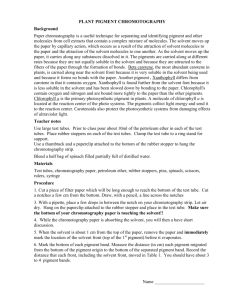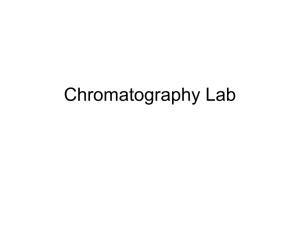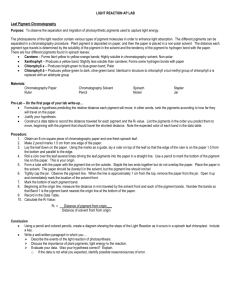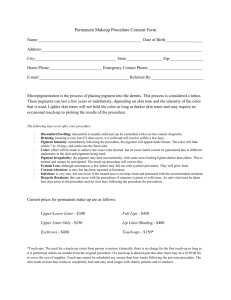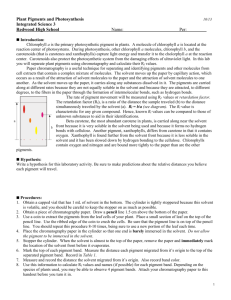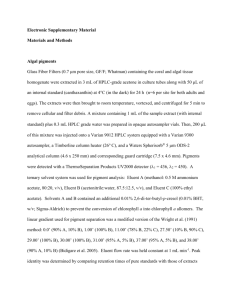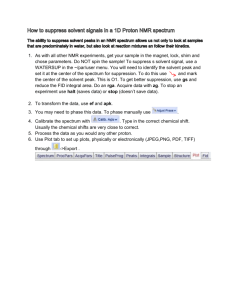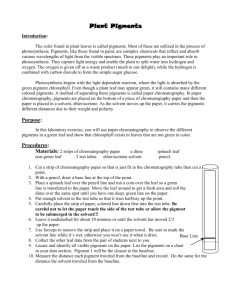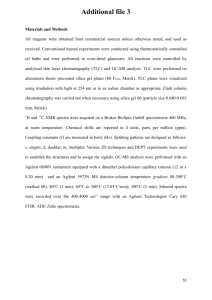Results
advertisement
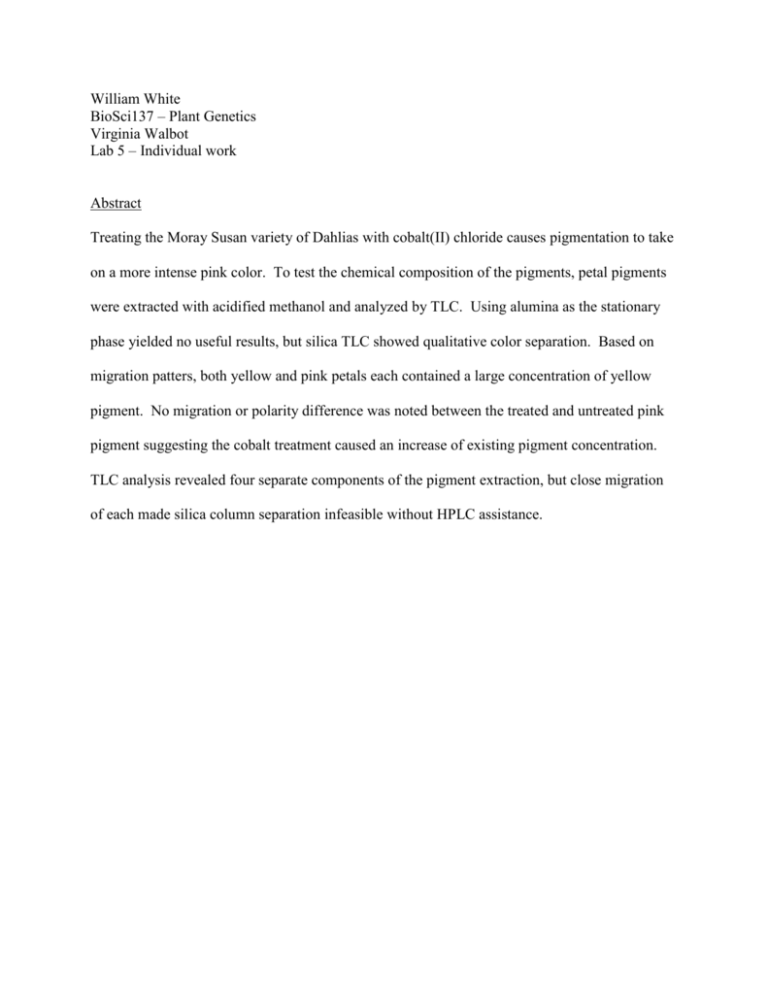
William White BioSci137 – Plant Genetics Virginia Walbot Lab 5 – Individual work Abstract Treating the Moray Susan variety of Dahlias with cobalt(II) chloride causes pigmentation to take on a more intense pink color. To test the chemical composition of the pigments, petal pigments were extracted with acidified methanol and analyzed by TLC. Using alumina as the stationary phase yielded no useful results, but silica TLC showed qualitative color separation. Based on migration patters, both yellow and pink petals each contained a large concentration of yellow pigment. No migration or polarity difference was noted between the treated and untreated pink pigment suggesting the cobalt treatment caused an increase of existing pigment concentration. TLC analysis revealed four separate components of the pigment extraction, but close migration of each made silica column separation infeasible without HPLC assistance. Introduction \An interesting effect was revealed in a previous experiment with the Moray Susan variety when its developing flowers were treated with cobalt (II) chloride. Pictured in Figure 1 is a normal Moray Susan flower before treatment with the metal salt. After initial metal salt treatment, the flower pigmentation began to change to a deeper red color (Figure 2). After two weeks of constant cobalt treatment, the flower showed a drastic change with central section of fully yellow petals (Figure 3). From these results, I hoped to look into the pigment composition of the flowers to answer two questions. First, is the yellow pigment produced because the cobalt blocks the anthocyanin biosynthetic pathway so the yellow pigment builds up, or is the yellow pigment always present in the petals and it only becomes visible with excess cobalt addition? Second, is the pink pigment in the cobalt-treated flowers chemically different (e.g. ligated to the cobalt) or does the cobalt treatment cause existing pigment concentrations to change? At the time of the experiment, High Pressure Liquid Chromatography (HPLC) and the Liquid Chromatography-Mass Spectrometer (LC-MS) machines of the Stanford Chemistry department were being moved and were unavailable. Thin layer chromatography (TLC) was used as a crude substitute. TLC is a technique in which chemical mixtures are blotted onto a solid layer of alumina or silica. The plate is then placed in a shallow pool of solvent, and, as the solvent climbs up the plate, the chemicals migrate with the solvent. Chemicals can be separated on a TLC plate based on the compounds’ polarities and the polarity of the solvent mixture. Mobility is measured as the Retention factor (Rf) which is the ratio of the distance the spot migrates to the distance the solvent runs. Chemicals that migrate further up the plate (high Rf) are generally less polar then chemicals that migrate with a lower Rf.1 Materials and Methods Flowers from figure 3 were cut and slowly frozen in a -80ºC freezer along with an untreated flower. Petals were removed from the untreated flower, and both the red and yellow sectors of the cobalt flower. For pink petals, all visible yellow material was removed. Each petal was weighed and ground in a mortar and pestle with 1 ml acidified methanol (1%HCl, MeOH). The resulting mixture was centrifuged for 1 minute at 1400 rpm. The supernatant was removed. A 1:10 dilution of the supernatant was made with methanol and used for TLC analysis. Alumina and silica plates were cut into 8cm by 2.5cm rectangles. A pencil line was drawn ~2mm above the bottom of the plate and the three samples (control, treated-pink, and treated-yellow) were spotted onto each plate. Plates were placed in a glass developing chamber with 2ml of each solvent mixture inside. Plates were removed from developing chamber when solvent was ~2mm from the top of the plate and the solvent font was marked with a pencil. Colorless spots were visualized with a short-wave UV hand lamp. Each spot was marked and 1 For more information on TLC, visit http://orgchem.colorado.edu/hndbksupport/TLC/TLC.html the distance from the starting point. Rf values were calculated based on measurements made with a ruler. When streaks were evident, Rf was calculated from the spot’s center. Results Alumina None of the solvent systems worked well with the alumina plates. I began with a low polarity 70%hexanes/30% acetone and didn’t see any migration off the starting line. This was the same for pure acetone, acetonitrile (MeCN), and methanol (MeOH). Acidic methanol (extraction buffer) was used and no major migration was seen. The acidified methanol reacted with the zinc sulfide fluorophore on the plate and caused loss of fluorescence on the bottom half of the plate. It is possible some colorless components migrated with an Rf<0.5 and this would not have been detectable on the plate. It is possible that the protonated salt of the pigments were simply too polar, and that this polarity was preventing the pigments from mobilizing off the alumina surface. To fix this problem an alkalized methanol solvent was created with 2ml of methanol and 3 drops of pure triethylamine. The alkalized solution did show small migration (Rf about 0.1), but none of the colors separated. Silica Silica is a less polar molecule than alumina, so if the pigments were sticking to the alumina due to polarity they should be mobile on a silica plates. The table below contains the data from the solvent series. Table I:A Solvent system 70%Hex/30%acetone 50%Hex/50%acetone Acetone Acetonitrile (MeCN) 75%MeOH/25%MeCN MeOH Yellow 1 0.82 1 1 1 1 Bands (Rf's) [control + treated] Pink Colorless 0 none 0.1 0.71 0 none 0.1 none 0.68 0.62 0.71(large) ? Table I:B Bands (Rf's) [yellow] Solvent system Yellow Pink Colorless 70%Hex/30%acetone 1 0 none 50%Hex/50%acetone 0.82 0 (very small) 0.71 Acetone 1 none none Acetonitrile (MeCN) 1 none none 75%MeOH/25%MeCN 1 0.68 0.62 MeOH 1 0.78(small) ? Table I shows the migration of various spots for each solvent system used. The spots were observed for the pink, yellow, and colorless pigments. Rf is the ratio of the distance migrated over the total solvent distance. Rf’s of 1 indicates the spot moved to the top of the solvent line, and Rf = 0 indicates the spot did not leave the spotting line. Colorless spots were only scored if a visible colorless spot was separable from the colored pigments. A) TLC plate results for the treated and control plant, B)TLC results for fully yellow sectors. All three samples were spotted onto the same plates. Conclusions and Discussion The plate experiments revealed a few things about the anthocyanin composition. First, the yellow pigment migrates at a much higher Rf than the pink pigment, so it is likely less polar. The pink pigment and yellow pigment seem to be in different concentrations. In the undiluted plates, the yellow pigment smeared out across the entire lane, but the pink pigment migrated as a much smaller blob. At ½ dilution the yellow continued to smear but the pink migrated as a distinct spot. Only at 1/10 dilution did the yellow show a clear spot instead of a smears suggesting yellow was in fact a pigment present underneath the pink color. Third, the cobalt treated and control pink pigments comigrated in every solvent system. In silica, an unligated chemical will normally have a radically different migration patter than a metal deficient ligand, so it is possible that the pigments are the same for the two purple plants but only vary in concentration. Finally, every color pigment comigrated with a colorless spot which would have made silica column separation an unfruitful venture. For clean separation, no two components should have an Rf less than 0.2 of separation on the plate. For this experiment, every color migration was matched with a spot about Rf=0.1 away. This suggests that an automated column such as HPLC would be required for clean separation of the components in this lab. This lab does reveal that up to 4 different components (and likely more) would be detected by HPLC analysis. The data from this lab clearly answers one of the initial experimental questions. The yellow pigment was in fact found in seemingly high concentrations in all petals suggesting that the yellow may be a foundational color for the Moray Susan plants. The TLC plates are not quantitative so the relative concentrations are a rather rough estimate. The second question of whether the pink pigment is different in treated versus untreated is not as clear. The pink spots did co-migrate in every solvent system suggesting they have the same polarity and are likely the same compound. This suggests that addition of the cobalt to the flowers alleviated cobalt as a limiting reagent in the pigment formation. Further experiments to test this hypothesis would be treating the petal extract with a strong chelating system which would remove any metal ions from the pigments. By removing the metal one could see if the cobalt (or some other metal) was part of the pigment or if it was only affecting the pigment biosynthesis. Further separation would use an HPLC system separate the compounds. HPLC is similar in concept to TLC and silica column chromatography, but it uses a flame detection system to detect minute amounts of various compounds of differing polarity. In addition, HPLC effects separation with very high pressures, so better resolution is typically seen than in TLC. Using an HPLC, the pigments could be separated in a clean manner and further characterized.
